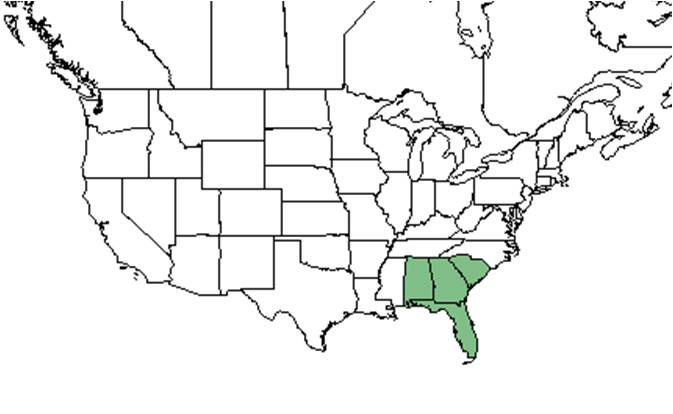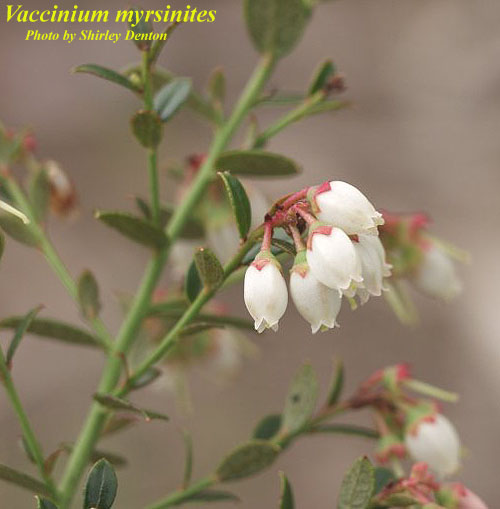Vaccinium myrsinites
| Vaccinium myrsinites | |
|---|---|

| |
| Photo by Pat Howell, Atlas of Florida Vascular Plants | |
| Scientific classification | |
| Kingdom: | Plantae |
| Division: | Magnoliophyta - Flowering plants |
| Class: | Magnoliopsida – Dicotyledons |
| Order: | Ericales |
| Family: | Ericaceae |
| Genus: | Vaccinium |
| Species: | V. myrsinites |
| Binomial name | |
| Vaccinium myrsinites Lam. | |

| |
| Natural range of Vaccinium myrsinites from USDA NRCS Plants Database. | |
Common names: Shiny blueberry, Southern evergreen blueberry
Contents
Taxonomic notes
Synonym: Cyanococcus myrsinites (Lamarck) Small var. myrsinites
Description
A description of Vaccinium myrsinites is provided in The Flora of North America.
Distribution
Ecology
Habitat
V. myrsinites responds both positively and negatively to heavy silvilculture in North Florida. [1] When exposed to soil disturbance by military training in West Georgia, V. myrsinites responds negatively by way of absence.[2] It also responds negatively to soil disturbance by agriculture in Southwest Georgia.[3] V. myrsinites responds both positively and negatively to soil disturbance by clearcutting and roller chopping in North Florida.[4]
Phenology
V. myrsinites has been observed to flower January to April with peak inflorescence in March.[5]
Seed dispersal
This species is thought to be dispersed by consumption by vertebrates. [6] In particular, it has been found to be dispersed by the gopher tortoise (Gopherus polyphemus).[7]
Pollination
The following Hymenoptera families and species were observed visiting flowers of Vaccinium myrsinites at Archbold Biological Station: [8]
Apidae: Nomada fervida
Halictidae: Agapostemon splendens, Augochlorella aurata, A. gratiosa, Augochloropsis anonyma, A. metallica, A. sumptuosa, Lasioglossum pectoralis
Leucospididae: Leucospis slossonae
Megachilidae: Coelioxys sayi, Megachile brevis pseudobrevis, M. mendica
Sphecidae: Ectemnius rufipes ais
Vespidae: Parancistrocerus salcularis rufulus, Pseudodynerus quadrisectus, Stenodynerus fundatiformis, S. histrionalis rufustus, S. lineatifrons
Conservation and management
Cultivation and restoration
Photo Gallery
Flowers of Vaccinium myrsinites Photo by Shirley Denton (copyrighted- use by photographer’s permission only), Atlas of Florida Vascular Plants
References and notes
- ↑ Conde, L.F., B.F. Swindel, and J.E. Smith. (1986). Five Years of Vegetation Changes Following Conversion of Pine Flatwoods to Pinus elliottii Plantations. Forest Ecology and Management 15(4):295-300.
- ↑ Dale, V.H., S.C. Beyeler, and B. Jackson. (2002). Understory vegetation indicators of anthropogenic disturbance in longleaf pine forests at Fort Benning, Georgia, USA. Ecological Indicators 1(3):155-170.
- ↑ Kirkman, L.K., K.L. Coffey, R.J. Mitchell, and E.B. Moser. Ground Cover Recovery Patterns and Life-History Traits: Implications for Restoration Obstacles and Opportunities in a Species-Rich Savanna. (2004). Journal of Ecology 92(3):409-421.
- ↑ Lewis, C.E., G.W. Tanner, and W.S. Terry. (1988). Plant responses to pine management and deferred-rotation grazing in north Florida. Journal of Range Management 41(6):460-465.
- ↑ Nelson, G. PanFlora: Plant data for the eastern United States with emphasis on the Southeastern Coastal Plains, Florida, and the Florida Panhandle. www.gilnelson.com/PanFlora/ Accessed: 14 DEC 2016
- ↑ Kay Kirkman, unpublished data, 2015.
- ↑ Carlson, J. E., E. S. Menges, and P. L. Marks. 2003. Seed dispersal by Gopherus polyphemus at Archbold Biological Station, Florida. Florida Scientist, v. 66, no. 2, p. 147-154.
- ↑ Deyrup, M.A. and N.D. 2015. Database of observations of Hymenoptera visitations to flowers of plants on Archbold Biological Station, Florida, USA.
